Items
Tag
coveryourfangs
-
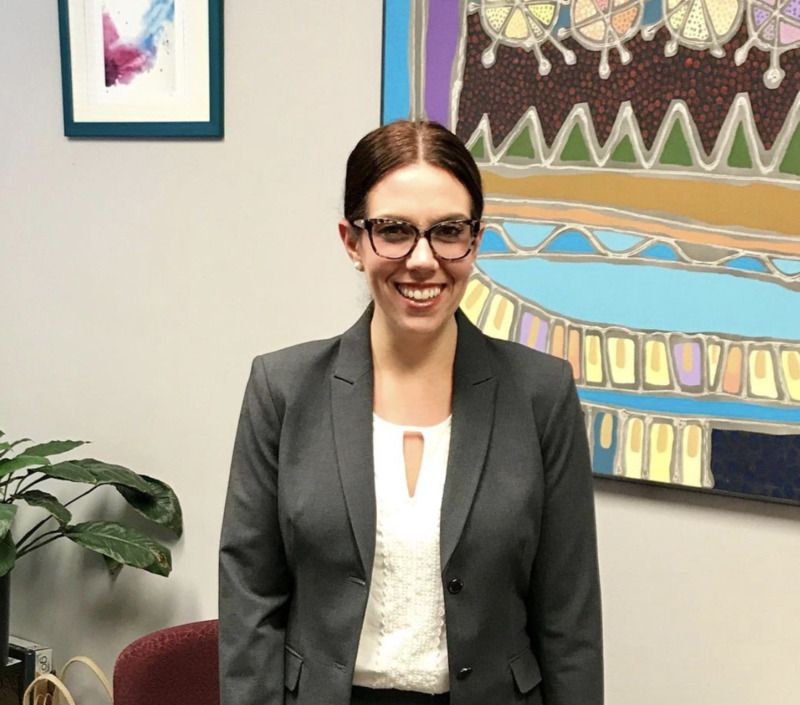 2021-11-03
2021-11-03Oral History: Clare Acosta
Through this oral history, Clare Acosta and I develop a conversation about both the Community Engagement office work and the program of Empower: Ecuador. The conversation was specifically focused on the before and after of COVID-19 and also what was learned from the process. It is a very deep conversation that I really enjoyed and know that Clare also did. -
 2020-11-02
2020-11-02Running from the Virus Like...
This item gives a sneak peek into a workout by St. Mary's University Baseball team. Their workout outdoors allows everyone to be spread out and maintaining social distancing requirements. -
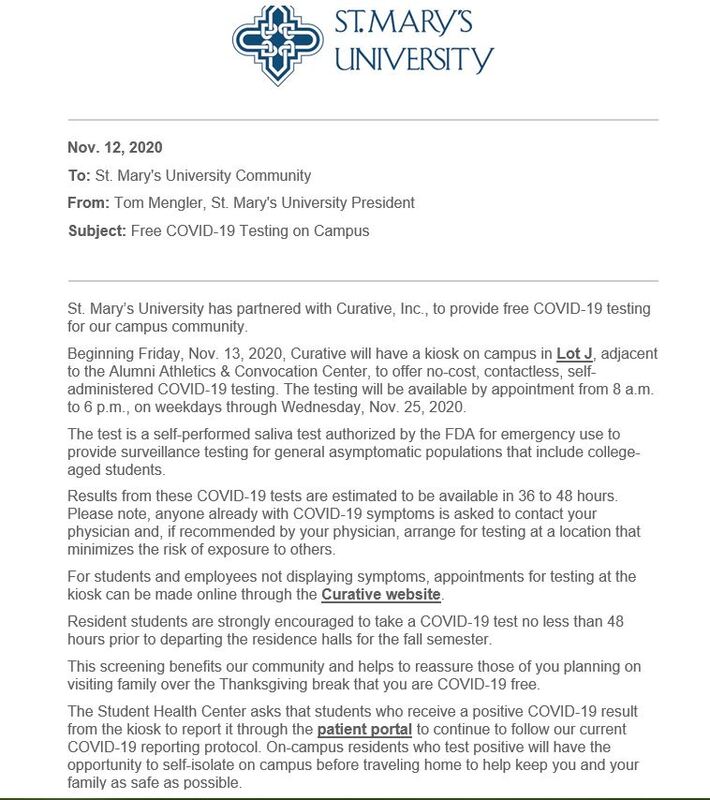 2020-11-17
2020-11-17Campus Offers Free COVID-19 Testing
In preparation for the holiday break, St. Mary's University is now offering its community free COVID-19 testing on campus. The test is a self-performed saliva test and it yields results within 36 to 48 hours. Located in front of the Alumni Athletics & Convocation Center, it is in a central campus location and easily accessible. -
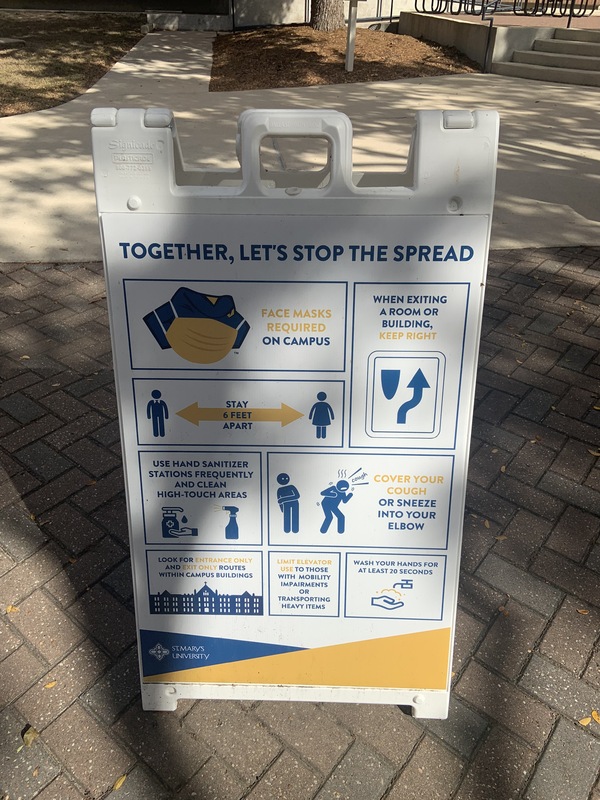 2020-10-27
2020-10-27Together we can protect St. Mary's University
Together we can protect St. Mary's University! Signs like these are in place to remind students at St. Mary's University to remember the new COVID19 safety guidelines put in place to protect the university and the St. Mary's Community. The signs remind students to wear their masks, keep their social distance (about six feet), to wash their hands, to use hand sanitizing stations placed around campus for their health and safety, and to mind the direction they walk in public areas like dorm hallways or large public spaces. -
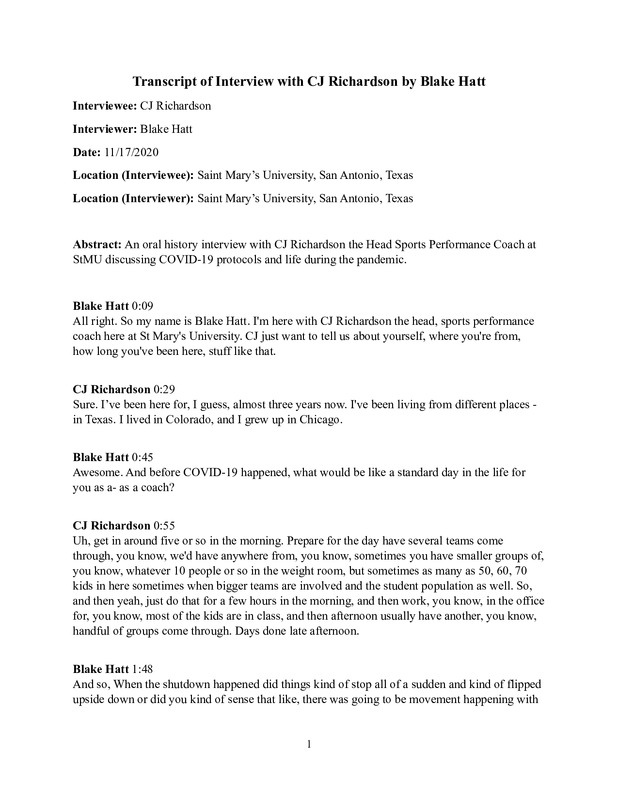 11/17/2020
11/17/2020CJ Richardson Oral History, 2020/11/17
An oral history interview with CJ Richardson the Head Sports Performance Coach at StMU discussing COVID-19 protocols and life during the pandemic. -
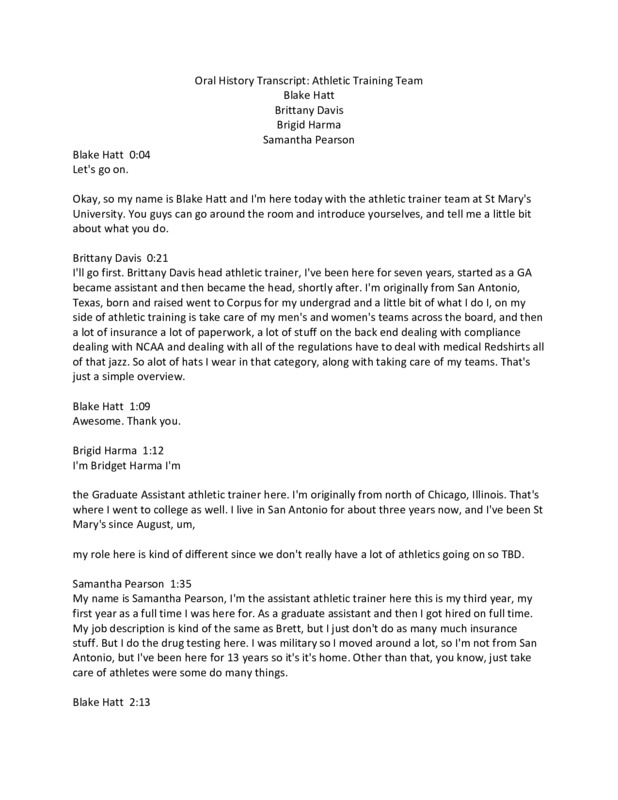 2020-11-17
2020-11-17StMU Athletic Training Team Oral History
This oral history features the athletic training team and their experiences in their positions at St. Mary's University since the beginning of the COVID-19 Pandemic. -
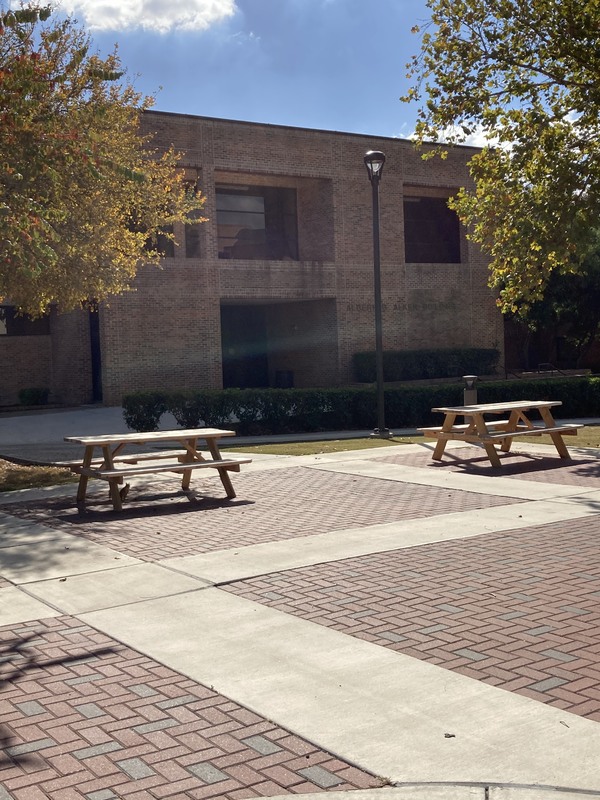 2020-11-16
2020-11-16Campus Adds Socially Distanced Seating
With campus dining switching to only offering to-go options, St. Mary's added numerous picnic tables throughout campus. These picnic tables are made of rough wood but they allow students socially distanced seating options, instead of having them return all the way back to their dorms to ear. -
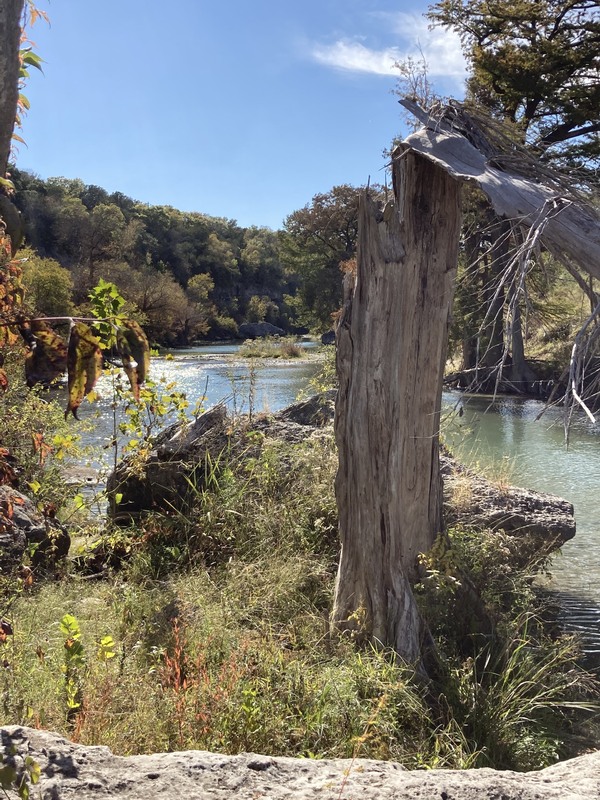 2020-11-16
2020-11-16Pandemic Hiking, Guadalupe River State Park
I had not gone hiking since before the pandemic so I was nervous about this first trek out. I had to wear a mask when entering any buildings but other than that things were the same. I chose to go to the Guadalupe River State Park since it was one I had not previously visited. I was surprised at how many people were at the park on a weekday but it was easy to be away from people the farther you were from the water. I had a mask on anytime I had to walk near someone, but hiking on the Barred Owl and Bauer Trail I didn't run into anyone. Attached are photos from an isolated pocket I found where I could spend time with my feet in the cold river. For the first time in months, I felt a sense of normalcy. Besides the mask and the need to make reservations beforehand, nothing about this hiking experience was exceptional, and yet I felt completely renewed as I huffed and puffed back to my car. I hope that people still take precautions when they can. -
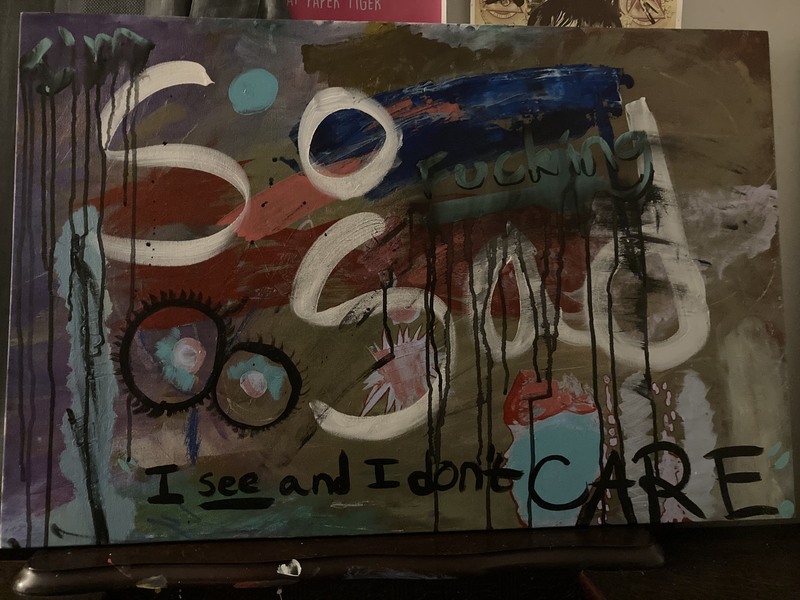 2020-11-16
2020-11-16Isolation Art
Isolation Art, 2020 Acrylic on canvas, 36x24 Between March 24th and June I was working remotely, and terrified to leave the house. I tried to get into new hobbies and thought that FaceTime would be sufficient for human connection, but it was not. Several personal milestones were accomplished during those months and not being able to physically be with my family was tough. The anniversary of my father’s death was the most difficult even to grapple with alone, but I could not help but wonder who else had lost their father that day because of COVID. So, I painted. It’s difficult to tell, but the words on the canvas read, “I’m so fucking sad. I see and I don’t care.” The headspace I was in was not a good one but I am grateful that I was able to get out what I needed to when I needed to. I listened to the news daily and every time that number rose my heart sank further and my anxiety deeper. I have since repurposed the canvas and painted over it, but this photo remains. -
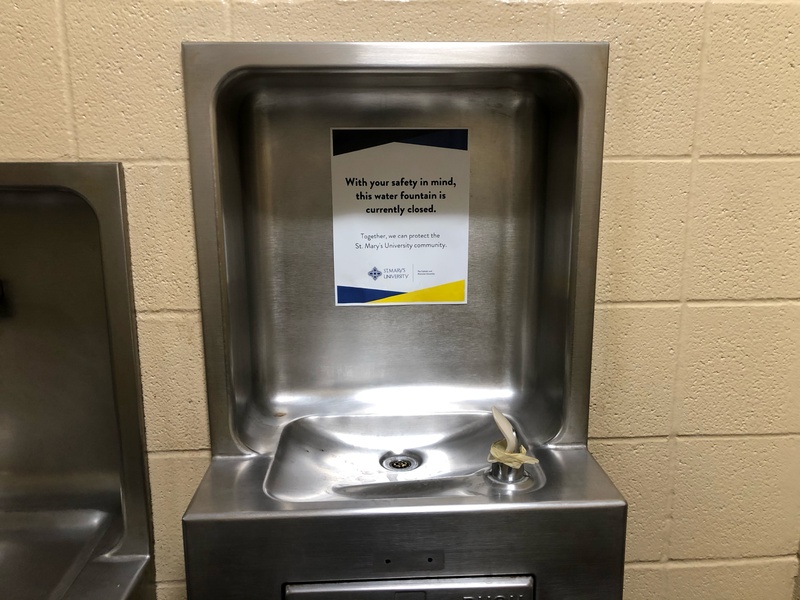 2020-11
2020-11Preventing the Spread of COVID-19 one Water Fountain at a Time
This photograph was taken of a water fountain in the athletics and recreation building at St. Mary's University. The water fountains are all blocked off with signage in the building besides the fountains that allow for the placement of a water bottle beneath it to be filled, unable to directly drink from it. -
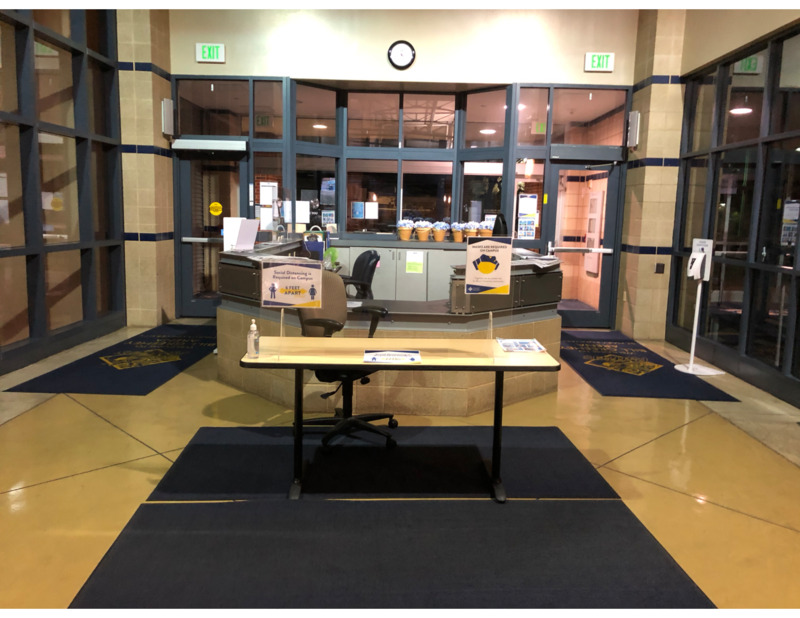 2020-11
2020-11A New Entrance to the Realm of Recreation
The photograph was taken in the AACC at St. Mary's University. Prior to the pandemic visitors would check-in using their ID cards. Now, patrons must create an appointment online and check-in at the only entrance, get their temperature taken, and leave once their hour appointment is up. This may seem like an inconvenience to some but it is a necessary procedure to ensure the spaces on campus are used safely. -
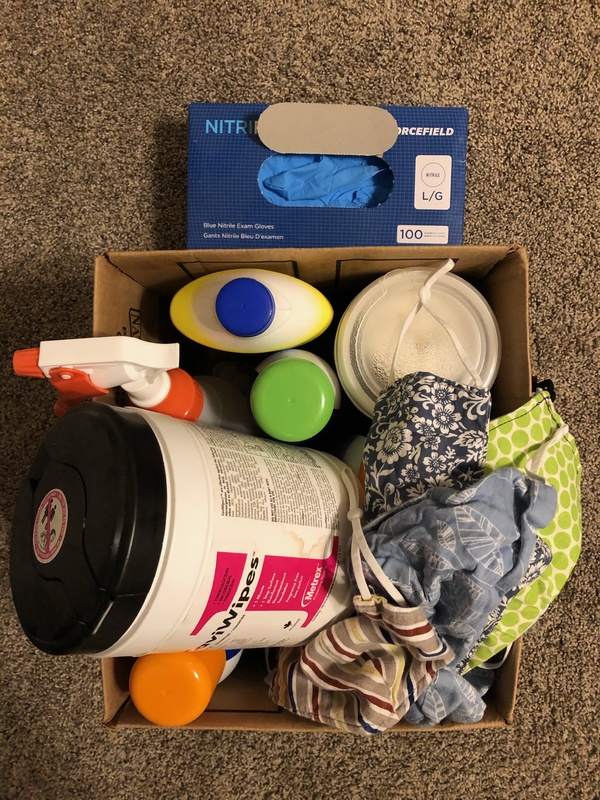 2020-08-06
2020-08-06A New Passenger Seat Rider
This August I prepared myself to drive almost 48 hours from my home to attend and work at St. Mary's University. As one may imagine there were many hoops to jump through as an international student coming to the United States during a pandemic. One of the most important aspects of my travels was to stay safe. Before leaving my family helped me put together my passenger. A box I kept in my passenger seat to be easily accessible in my fully packed hatchback. In this box, I kept sanitizing spray, hand sanitizer, a spray bottle to clean my hotel room surfaces, gloves and masks. By using the contents within the box and respecting CDC guidelines I successfully made my trip from the Great White North safely. -
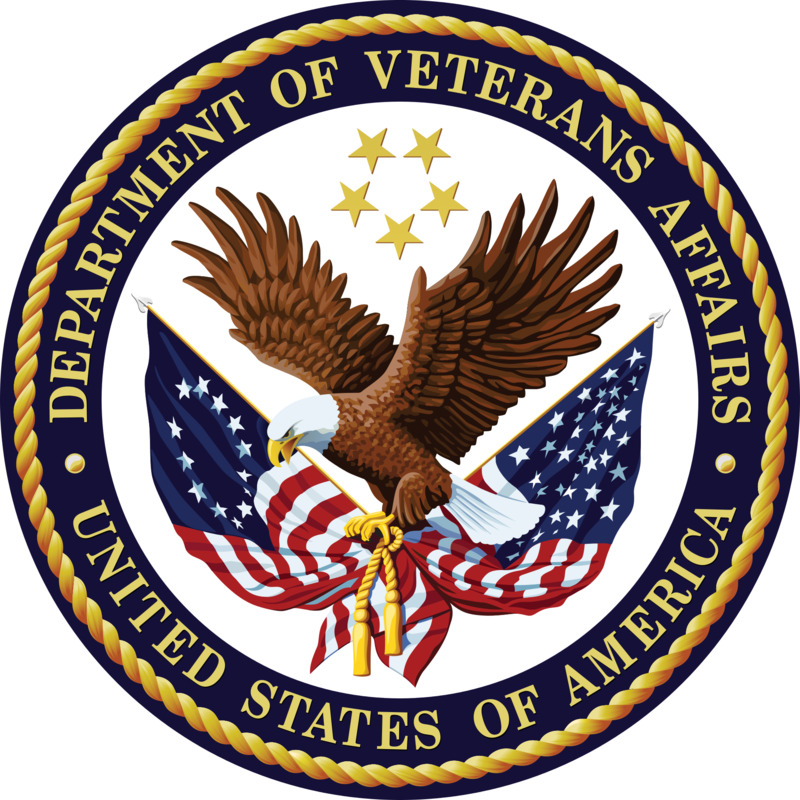 2020-10-27
2020-10-27How has COVID-19 challenged your VA 2020 school registration?
Reaching out to my school's student veterans, I was able to acquire one response. I emailed out a few questions about how the Covid-19 pandemic effected their registration process, and any other thoughts that may pertain to school and the pandemic. Even for myself, trying to find volunteers to participate in this project is difficult; not being able to visit the campus and collaborate with classmates proved I did not have an abundance of volunteers to work with at a moments notice. Before the pandemic we were able to ask for almost anyone's help with school projects, something that seems like a luxury at this time in the middle of Covid-19. I want to thank the individual for participating in my project, and wish them well with their classes throughout this difficult times that we are experiencing. -
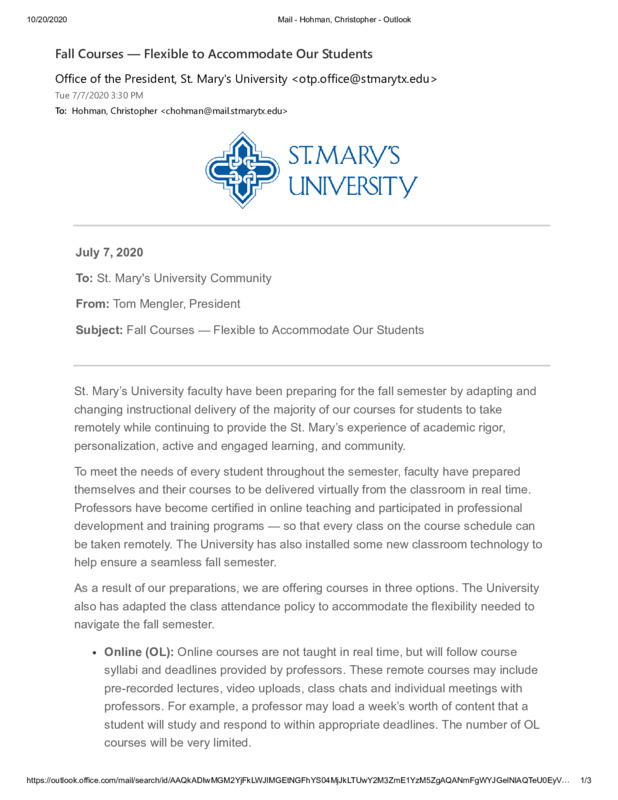 2020-07-07
2020-07-07Fall 2020 Course Format Options for Students at St. Mary’s University
This email was sent out to the St. Mary’s University community on July 7, 2020, to explain the three different formats in which courses would be offered for the Fall 2020 semester. The university would offer three different formats for the then-upcoming semester. The first format offered was online courses (OL). These courses were not taught in person, but they still follow a syllabus and have course deadlines. They could include pre-recorded lectures, video uploads, class chats, and individual meetings with professors. The next course format offered was Virtual (V). These courses would meet at an appointed time and date, similar to a normal in-person class, but on the Zoom conference platform, and they would be led by a professor who could be teaching from a variety of different environments. They would not meet in person or on campus, just virtually. Similar to online courses these courses might also include class chats, video recordings, and one on one meetings with professors. The last course format offered was In-Person Virtual (IPV). These courses were designed as hybrid courses. Students would be able to attend these courses in person in a traditional classroom environment (though class size would be limited), or they could attend the class virtually through Zoom. All of the course formats described above were offered by my university in response to the COVID19 pandemic, and they demonstrate the need for adaptation and change in the era of COVID19. The author of this post has been able to attend both virtual and in-person virtual classes at St. Mary’s University this semester. Speaking from firsthand experience, I can attest to how different being in the classroom is this semester. There are not a lot of students in the class; at most maybe three students on any given day. Those of us in the classroom, students, and teachers, sit in socially distanced seats, and we all have our masks up. Regardless, I am grateful that I have had the chance to try to forge a new normal for myself during such an abnormal time for our university and our world. -
 October 14th 2020
October 14th 2020Socially Distanced Sports Performance
Due to socially distancing guidelines at St. Mary's University the sports performance team has been forced to be creative in the ways they train their athletes. This includes having team workouts outdoors, using the spaces they have. This allows the teams to workout during the day together when the recreation and athletic center is being used by the public. The athletes are challenged by the Texas heat at times but they love a challenge. -
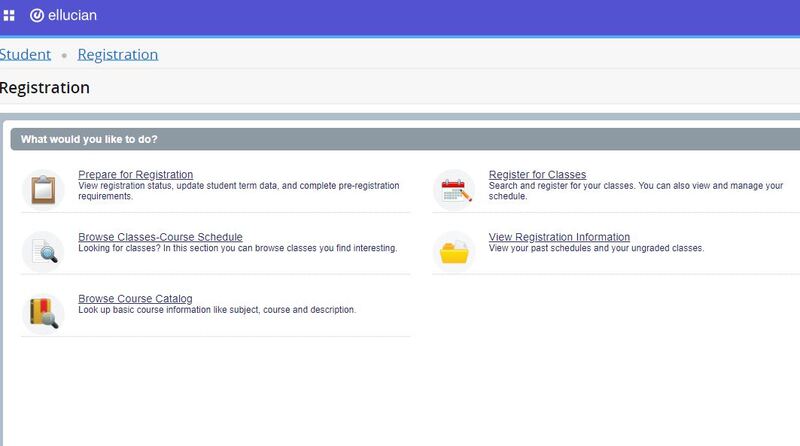 02/01/2020
02/01/2020Registering for School During COVID-19 for a Veteran
Registering for my Masters program”2020” was a bit more difficult and time consuming than usual. During Covid-19 “Lock-Down” I could not walk into offices to take care of business like I normally do. Communication was directed through E-Mail, and video calls. First of all, I am not a big fan on emails. I have never considered it an official form of communication. I myself being in the military, and traveling the majority of the year, was subject to scrutiny about not responding to emails when I was traveling around the world. At the time, many places in the world did not have WIFI, and by the time I had arrived from my trips, deadlines had passed; not like I was going to make any kind of meeting while I was on the road anyway. The digital highway is not convenient for me for many forms of communication. Applying for Federal Aid was normal, that has been an online process sense the beginning of my college career but addressing my VA school benefits was another story. Contacting VA coordinators and councilors meant that communication drastically slowed down. During Covid-19, offices were closed, office workers were moving their offices home, and the VA was rapidly changing the process of doing business with its members. This meant that I could not meet with a benefits counselor in my hometown but get a response e-mail from them that would lead me to a national pool of counselors. Applying for school benefits and having the process approved took approximately 5 – 6 months, 4 maybe 5 months too long. I can only guess that the entire system has been compromised because of the Covid pandemic, and the slow to respond, “email effect.” -
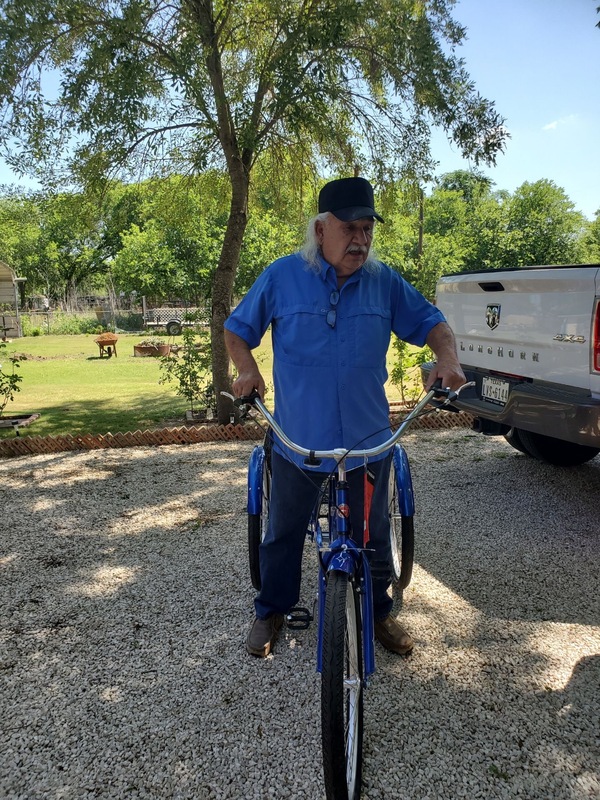 06/01/2020
06/01/2020COVID-19 Has No Boundaries for Those That Mourn
February 2020, Covid-19 was a drop in the bucket, it’s coming to the U.S. from China. What is it? Where did it come from? How will it reach us? Do we close our boarders? Stop international travel? Who is to blame? The first of the infected to arrive, from China, landed at Kelly Field San Antonio TX, and were set into quarantine. Fast forward about a month (end of March), and I am picking my dad up from BAMC (Brook Army Medical Center), he had been dropped off by his wife, and she was not allowed to stay at the hospital. He was seen at the ER because of stomach pain and continuous vomiting. What was different and a little strange to me was the fact that the hospital would not allow his wife to enter the building, even if she was the only means of his being. Because of strict city, state, and national orders to covid-19, no one other that the patient was allowed to enter the hospital. After two months of going in and out of the hospital, military doctors had discovered a cancerous tumor growing in his liver, it was putting pressure against his bile duct not allowing his liver to function properly. An emergency procedure was scheduled, but without notice, it was cancelled before he was operated on. A second procedure (Y90) was scheduled, but part 1 of a two-part procedure failed and three days later we said goodbye to Art Reyes Sr. Planning for his services were difficult. We could only invite 10 people to the church and 20 people to the funeral home, but after gathering information about my dad’s services, my heart went out to those that had lost family and friends due to the Covid virus. Their services were completely canceled. If a person had died in a hospital of Covid-19, they were to be transported from the hospital, cremated, and buried without any type of service Had it not been for Covid-19, I think that Art Reyes would have had the rapid medical attention that he deserved. Doctors would have been “on the spot” in treating him for his condition, and not meeting just once a month to discuss someone’s condition with cancer. Many times, I felt that he was dismissed because of the covid-rules in place, but there also did not have to be poor/no communication between family and doctors. Funeral services would have been normal for more than 20 people to celebrate his death, and many family members that could not travel from out of town, could have celebrates with us also. The bottom line was his cancer inevitably was the cause for his death, but it wasn’t immediate. His death was due to his failing organs that were secondary to the tumor growth, and medical doctors on a “Corona19 Vacation.” -
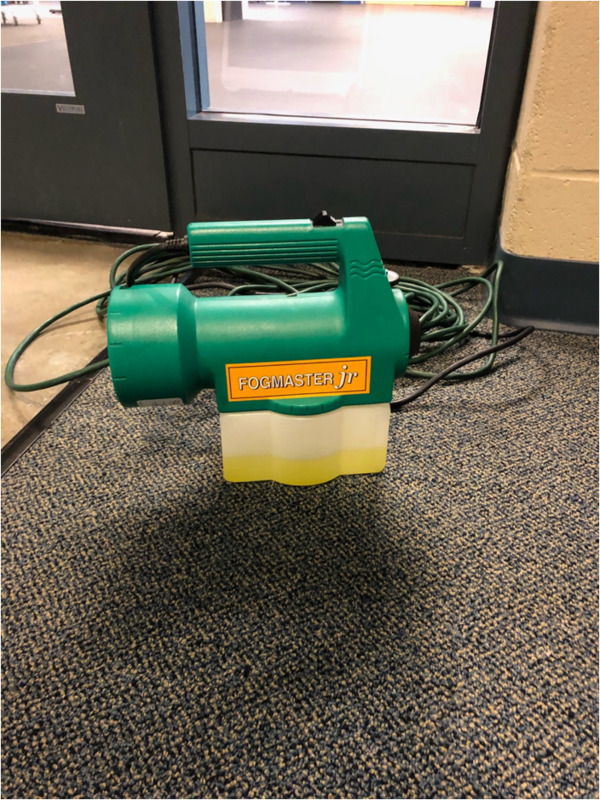 10/01/2020
10/01/2020New Sanitization Protocols
This fogger is a new sanitization device introduced to our daily cleaning regime at the Athletic Center. It plays an integral part in ensuring that the recreation spaces are sanitized for patrons and for athletes to use the spaces. The fogger is used by custodial staff at 10:00 am and 2:00 pm and the facilities must be closed for an hour each time. The fogger is also used at a closing time ensuring that the facility is sanitized for incoming athletes for their 6:00 am sessions. -
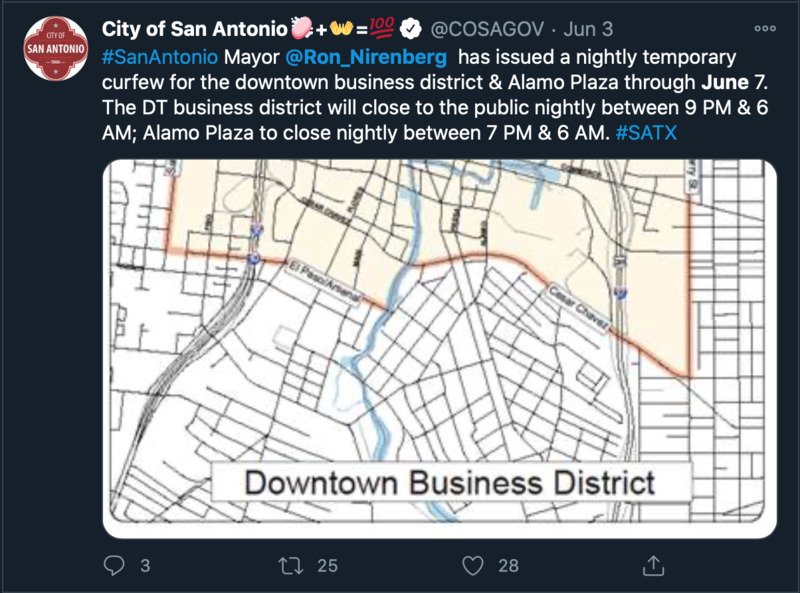 May 5, 2020 - August 31, 2020
May 5, 2020 - August 31, 2020M.A. in Zoom pt. 2: The Myth of Summer
This entry is the second part to capturing what the first six months of my graduate school experience was like. I’m a graduate student in the public history program at St. Mary’s University in San Antonio, Texas. I, like many students throughout all levels of education, felt a dramatic shift during or following spring break 2020. As the world began to catch on fire, I was just starting to piece together my final project which would enable me to graduate with my M.A. degree. Despite the chaos, I managed to survive the rest of the semester, and actually get a good head start on my project. I achieved two new job opportunities and reunited with my boyfriend after going two months without seeing each other. Things were going really well for me and I found a sense of confidence I hadn’t felt in three months. A confidence that might’ve crossed the line into arrogance. This is when I actually got serious about the pandemic. I chose to forget that just because things were going well in my world, didn’t mean things were going well in the real world. I, along with many of my fellow citizens, gave in to the idea that the south Texas heat would significantly curb the spread of the virus. As Texas began to open up, I began going out–not just for academic purposes but also for my own selfish desires to feel myself again. I returned to my local gym. I ate out (in doors) at restaurants. I went to an outdoor bar with my parents (one that was not abiding by the six feet separation policy). I heard the medical experts’ warnings against the loosening of restrictions; I was aware of the slowly but still increasing COVID cases in the city, but chose to act selfishly. This selfishness transferred over to my academic goals. I was blinded by my ambition (or anxiety) to hit the ground running with my capstone. Maybe I knew that after a certain point, it would no longer be safe nor socially acceptable to meet with people outside of my immediate community. The second and third photos were taken from the first sets of oral histories I conducted with my community partners, the Ballet Folklórico de San Antonio. This is Bonnie Ramos and Mark Molina, the head creative directors of the Ballet Folklórico de San Antonio. Prior to these interviews, I had to meet with these leaders to plan out these interviews. We were all fully ready to conduct in-person oral histories not only with these two, but also their friends and family members. In the second photo, we were more conscious of the virus as you can see Ms. Ramos is wearing a mask. However, in the following interview with Bonnie and Mark, done just [two] weeks later, you can see that we chose to let our guards down (falling in line with the rest of the San Antonio, and overall Texas, community). In both photos we made sure to keep a distance between us, but we did not measure exactly six feet. Off camera, we also made sure to interact at a distance, however, we all chipped in to set the interview setting. In between interviews I came down with a case of strep throat. I had to get tested for COVID and the results came two days later, which means my family and I held our breaths for two days. Thankfully I was negative, but strep really kicked my butt. I thought to myself, “If this is what strep feels like, I don’t want to know what COVID feels like.” The doctor was very sure that I only had strep because I had no other symptoms (such as respiratory difficulties). However, COVID is different for everyone – so I heard. I began to drown myself in COVID statistics which made me feel even worse; but also made me snap and understand that I cannot be my control freak self in the midst of a pandemic. Included are some images of COVID statistics in San Antonio from the point that I contracted strep until the end of August. I thought about all the times I had gone out, regardless of being aware that I shouldn’t; I thought of all the people I had interacted with and how ashamed I’d me if I would have to call them; I thought of what I could potentially be putting my parents through because they have underlying conditions (diabetes and asthma). After a few days on antibiotics I was alright, but this was a wakeup call and my Ballet Folklórico project came to pause. Then Fourth of July hit, and San Antonio really milked the reduced restrictions. In the following weeks, San Antonio saw a spike in COVID-19 and the city promptly regressed back to prior restrictions. I cancelled my gym membership, my family cancelled our annual trip to the beach, and abstained from interacting with some friends and family. My household became a little blue; I felt a mixture of shame, fear, and frustration (towards myself and the state of Texas). As a public historian, I felt like I failed the community I serve by acting in my self-interests. Public historians share a larger responsibility to treat out community justly and with respect. However, I chose to contribute to the problem that I knew was still there; I gave in to my selfish desire for “normalcy” and potentially put my community partners at risk. Luckily, neither of us (myself, Bonnie & Mark, nor my camera man) have experienced any COVID-19 symptoms following our interviews nor up until now. Throughout the rest of the summer, all of the oral histories I conducted for my capstone were done via Zoom. My project was slowly transitioning to become a digital project, but I’ve come to see this as a strength and necessary change. It does not seem like Texas will have this virus completely under control, and many individuals will be hesitant to interact physically or outside their homes. Creating something digital will meet the needs of individuals while still taking precautions, as well as be more accessible to other researchers beyond San Antonio. COVID had made me acquaint myself with advanced-ish technology that will make all my projects throughout my career more accessible and therefore more equitable -
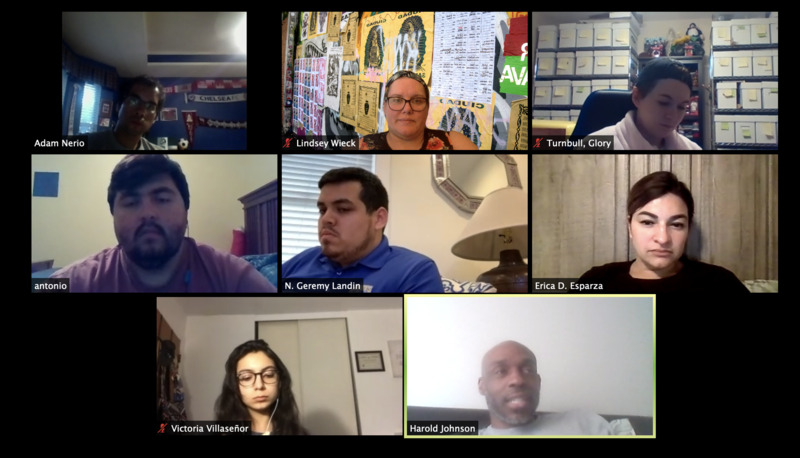 March 8 2020 - May 4, 2020
March 8 2020 - May 4, 2020M.A. in Zoom pt. 1: Initial Anxieties & Adaptation
This entry is part one of two entries that capture the first six months of my graduate school experience. I’m a graduate student in the public history program at St. Mary’s University in San Antonio, Texas. I, like many students throughout all levels of education, felt a dramatic shift during or following spring break 2020. Most institutions, like mine, extended our spring break by a week to brace campus for transitioning fully online. At this time, I was enrolled in a course called “Conceptualizing your Capstone.” As the world began to catch on fire, I was just starting to piece together my final project which will enable me to graduate with my M.A. degree. Perfect timing. These are images of what my first semester of graduate school kind of boiled down to: completing the initial, most crucial, stages of my capstone virtually and completing my fellowship with what I felt were limited resources. What is not pictured was my constant fear of the unknown. Initial Anxieties For my capstone project I’ll be looking at the development of ballet folklórico in San Antonio and its influence throughout the state of Texas. I was looking forward to digging in our university and local archives; Fiesta was around the corner and I would’ve used that as an opportunity to document the different folklórico groups set to perform; and most importantly I had planned on meeting with the community members I’m working with face-to-face. The last point there was particularly concerning for me. I’d have to reach out remotely to a community who seldom opens their vaults to outsiders. How was I going to establish credibility and convince these groups that they could trust me via an email or Facebook message? The whole concept of my capstone project also might’ve had to change. I was originally looking to create a narrative history of Ballet Folklórico in San Antonio by drawing on the experience of my community partners–they are the earliest 501(c)(3) groups established in the city. In regard to my schoolwork, how was I going to produce legitimate work from the confines of my house? Was I even in the right place mentally and emotionally to perform at graduate level amidst social, political, and medical disarray that was being broadcasted? I was starting to get cabin fever; I could’ve ignored the commotion outside so I could focus, but that felt selfish. How could my mind be everywhere at once, yet my body needed to remain indoors? (These are actually a bunch of large questions I’ve had swirling in my head throughout the rest of March.) In late March, one of my brothers who’s a Texas State Trooper was ordered to quarantine for two weeks after someone in his unit contracted the virus. Then in mid-April, my other brother came down with something that gave him body aches, chills, fever, and made him sleep all day. No respiratory issues, however, we had no idea what was going on. He got tested for COVID and his results took four days to come back. Both my brothers tested negative, but these two events made it seem like the virus was everywhere and inhibited my ability to think and produce sound work. Adaptation After a couple of dramatic weeks, I got to a point where I could realize the amount of privilege my family and I managed to hold on to regardless of the dystopian-like transitions we were going through as a society. My dad and brothers could still commute to work (that has never been compromised throughout the past nine months), and my mom and I have been able to work from home; neither of us experienced a cut to our pay nor hours; I could get back to a regular sleep schedule because I no longer had to commute from campus, which is on the other side of town, late at night; we have stable WiFi; we have insurance; we’ve been able to pay our bills on time. In terms of academics, contrary to my initial anxieties, my experience in graduate school wasn’t really compromised. I had already established relationships with my peers and professors so Zoom classes and weekly meetings for my fellowship didn’t feel so awkward. Even if I didn’t have the first half of the semester to acquaint myself with my classmates, my generation is very much accustomed to digital communication. We literally grew up on it; we witnessed the evolution from wall phones to smart phones. Making digital connections isn’t a foreign concept to me. The pace of graduate school also didn’t change much. Yes, not having to commute to campus really alleviated a lot of my stress. However, the sense of urgency in graduate school did not fade one bit. I also underestimated the digital literacy of older generations. Specifically of the ballet folklórico community throughout Texas. Through the power of Twitter, Facebook, JSTOR, online university archives, and Zoom, I was able to build upon my research for my capstone. The individuals and groups I reached out to for help were surprisingly eager and generous. Maybe we were all craving some new faces or voices to interact with, or maybe I underestimated the power of engagement. I was able to build upon my capstone, and was probably more productive with it given that I had to stay in one place and work. Optimism was in the air. The first photo is a screenshot of our final presentations where we pitched our capstone idea to the St. Mary’s history department. We were originally set to present our capstone idea to the public history department (staff and students). Initially, I thought this experience would be compromised. I thought I’d miss out on forming connections with other professors in the program. However, there was a collective understanding these young academics (my peers and I) are in the midst of creating one of the most important pieces of our careers under unimaginable outside challenges. All hands were on deck in making sure we received the most help and access to whatever resources. It reinforced that I belonged to a community grounded in the belief that regardless of the circumstances, our duty is to assist each other in our pursuit to public history. I hope other graduate students across the city, state, country, and world experienced this same empathy.
